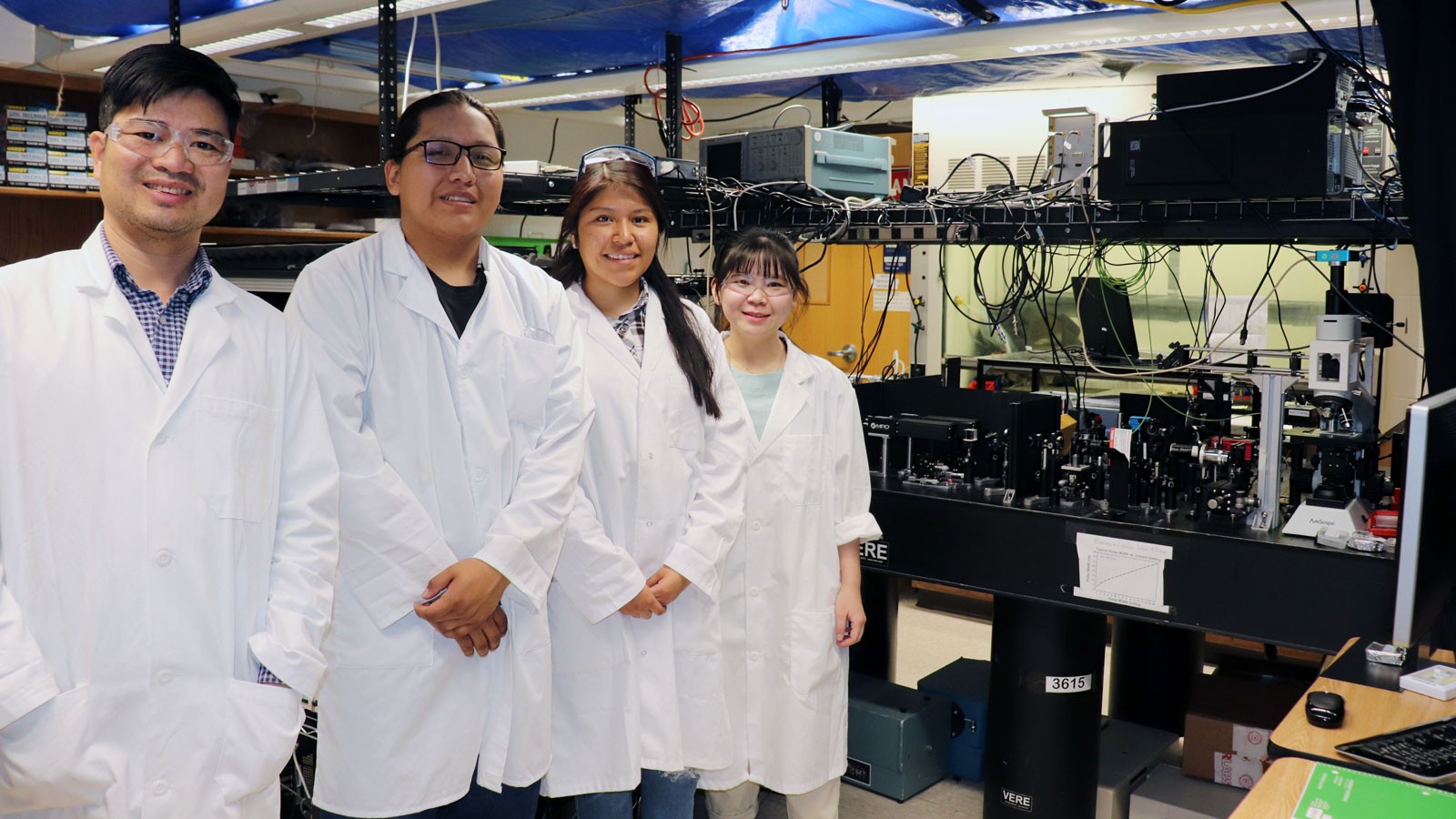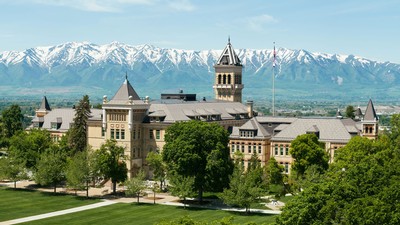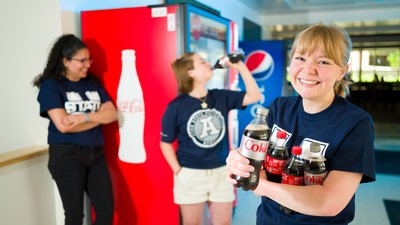It's a Small — and Colorful — World: USU Undergrad Scholars Explore Quantum Dots
In faculty mentor Tuan Trinh's physical chemistry lab, Native American Summer Mentorship Program participants Khiara Kinsel and Baahozhooni Little pursue nanoscale research. Along with other NASMP scholars, the undergrads present their research experiences Tuesday, June 11.
By Mary-Ann Muffoletto |
Video by Taylor Emerson, Digital Journalist, University Marketing & Communications
When you walk in a store to shop for a TV, you face a barrage of choices. What size do you want? Wall mount or stand? And, very importantly, what about display quality? Among the options you’ll consider is quantum dot (QD) technology for LCD screens that enhance color, brightness and contrast.
But what are quantum dots?
“Quantum dots are semiconductor nanocrystals that are 2-10 nanometers in diameter — about one ten-thousandth the diameter of a human hair,” says Utah State University chemist Tuan Trinh. “They absorb and emit light, and the color they emit is determined by how you manufacture their size and composition.”
In Trinh’s lab, small QD samples glow bright green, yellow and blue.
“Their physical properties make them very promising for such applications as displays, solar panels and bioimaging,” says Trinh, assistant professor in USU’s Department of Chemistry and Biochemistry. “Quantum dots were discovered about 40 years ago, but are emerging in cutting-edge applications. The selection of the trio of quantum dots researchers Bawendi, Brus and Ekimov for the 2023 Nobel Prize in Chemistry has generated a lot of excitement and shows quantum is not confined to the laboratory, but is becoming an important part of real-world applications.”
USU students Khiara Kinsel and Baahozhooni Little are among 18 Aggie scholars learning about QD and the university’s other research endeavors, as guests in Trinh’s lab during the 2024 Native American Summer Mentorship Program. In its ninth year, the program brings early undergrads from the Utah State University Blanding campus to the university’s main Logan campus for a monthlong visit. Participants learn about USU’s broad range of four-year bachelor’s degree programs and experience, first hand, undergraduate research in varied disciplines. Additionally, the students learn how these programs and experiences are building blocks to graduate and professional school opportunities.
“Science wasn’t my favorite subject in high school, but I’m seeing how hands-on learning, like we’re doing here in Dr. Trinh’s lab, is much more interesting and helps me get the gist of scientific concepts,” says Kinsel, who recently completed a certificate in engineering drafting and design, and plans to study civil engineering.
Little, who is majoring in general studies, earning a welding certificate and planning to pursue further studies in animal science, says he wasn’t sure what to expect from a chemistry lab.
“I didn’t know much about quantum dots and I thought this lab would be really hard,” he says. “But the more time we’ve spent in the lab, the more I understand the research. It’s very interesting.”
Trinh says a main aim of his research, funded by the university’s New Faculty Start-up Funding, is to improve the efficiency and performance of quantum dots, and to seek fundamental understanding of quantum dot behaviors at the nanoscale and ultrafast timescales.
“This technology has great potential and, with time, will provide advantages over other technologies in a number of applications,” he says. “As it advances, it will reduce costs and foster precision.”
For example, for solar energy generation, Trinh says, quantum dots have the potential to enable manufacture of more effective, lower cost solar panels. For medical applications, quantum dots will enable physicians to better pinpoint and remove malignant tumors, sparing more of the healthy, surrounding tissue.
And, TV viewers will enjoy sharper, brighter, more accurate color photos while watching their favorite sporting events, movies and shows.
Kinsel and Little, along with fellow NASMP scholars, will share their research experiences Tuesday, June 11, at 9 a.m. in the Fine Arts Visual Building (FAV), Room V150. All are welcome.
From left, USU Chemistry and Biochemistry faculty member Tuan Trinh, and doctoral student Kieu Nguyen, far right, mentor Native American Summer Mentorship Program scholars Baahozhooni Little and Khiara Kinsel, on quantum dots research. (Photo: USU/M. Muffoletto)
WRITER
Mary-Ann Muffoletto
Public Relations Specialist
College of Science
435-797-3517
maryann.muffoletto@usu.edu
CONTACT
Tuan Trinh
Assistant Professor
Department of Chemistry and Biochemistry
435-797-1673
t.trinh@usu.edu
Comments and questions regarding this article may be directed to the contact person listed on this page.







